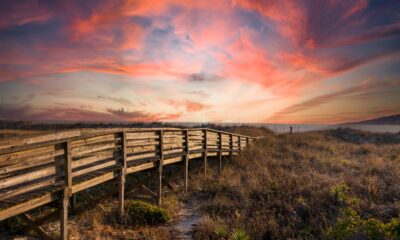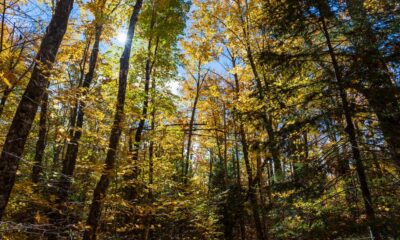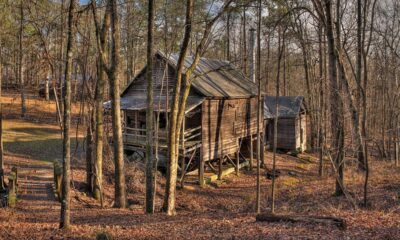California
Why grave robbers stole this gold miner’s skull in Joshua Tree in 1983
Published
3 weeks agoon

Johnny Lang’s Fatal Gold Theft at Lost Horse Mine
Johnny Lang fled to Lost Horse Valley in 1890 after gunmen killed his brother back in New Mexico. When his horses went missing, he tracked them to the McHaney Gang, known cattle thieves who held him at gunpoint.
There he met “Dutch” Frank, who sold Lang a gold claim for $1,000. The mine boomed, pulling out gold worth $5 million today.
But Lang had tricks up his sleeve. He stole half the gold during night shifts until his partner caught him red-handed with a private eye. In 1925, Lang vanished with a note saying he’d “be back soon.”
Three months later, someone found his body on the road to town. The gold he stole? Still missing.
The ruins of Lost Horse Mine stand today in Joshua Tree National Park, where visitors can see the massive stamp mill that once crushed ore while pondering where Lang might have hidden his stolen treasure.

Johnny and His Dad Fled a Deadly Shootout
Johnny Lang and his dad drove their cattle into Lost Horse Valley in 1890 after a bloody gunfight in New Mexico. Johnny’s brother and six cowboys got shot dead, forcing the family to leave everything behind.
The Langs camped in the valley when the area only had cattle and a few Native American camps. This violent start pushed them from cattle work toward a future with gold, lies, and danger.

Their Horses Vanished in the Desert Night
One morning the Langs woke up to find their horses missing. Johnny tracked them to the McHaney brothers’ camp at the Oasis of Mara.
These McHaneys weren’t just troublemakers but known cattle thieves hiding stolen animals in the area since the late 1880s.
When Johnny showed up asking questions, they pointed guns at him, denied having his horses, and told him to leave fast. This bad meeting led to an unexpected chance.

A Scared Prospector Wanted Out
At the thieves’ camp, Johnny met “Dutch” Frank Diebold who looked worried. Frank had found rich gold but was too scared to dig it up.
He had good reason to worry. The McHaneys had already killed another gold hunter named Frank James, forcing him at gunpoint to sign over his Desert Queen Mine before shooting him.
Dutch Frank wanted to sell his claim and run away with his life, giving Johnny a chance to switch from cows to mining.

The Deal That Started It All
Johnny and his father paid Dutch Frank $1,000 for the mining rights in 1890, naming it Lost Horse Mine after their missing horses that led to this lucky find. They weren’t foolish about the dangers.
Knowing the McHaney Gang might target them next, Johnny brought in three partners for safety.
The four men made everything legal by filing their mining claim in December 1893, starting what became one of the best mines in what later became Joshua Tree National Park.

Getting Gold Was Backbreaking Work
The partners built a two-stamp mill several miles from the mine where they could find water. This meant they had to load ore into wheelbarrows and push it all that way, making every day tough.
Despite these problems, the mine started making good amounts of gold.
The far-off location made everything harder, from getting supplies to breaking down ore, but the gold they found kept them going through all the hard times.

A Rich Rancher Changed Everything
J.D. Ryan, a wealthy Montana rancher, bought out Johnny’s three partners in 1895, bringing big money into the work.
Ryan found a steam-powered ten-stamp mill near the Colorado River, took it apart, and hauled it piece by piece to the mine. He built a 3.5-mile pipeline from his ranch wells to power the mill, going up 750 feet.
The 850-pound stamps crushed ore 24 hours a day, with their loud noise filling the valley, turning the small job into a real money-maker.

Gold Production Numbers Didn’t Add Up
From 1894 to 1931, the mine made over 9,000 ounces of gold and 16,000 ounces of silver, worth about $5 million today. Johnny ran the night shift while Ryan’s men worked days.
Ryan saw something odd: the day shift always made baseball-sized gold clumps while Lang’s night shift only turned in golf ball-sized amounts.
The gap was too big to ignore, and Ryan grew more worried as the pattern went on without any good reason.

The Secret Midnight Gold Thief
Ryan hired a private eye to watch the night shift without Johnny knowing. The detective caught Johnny sneaking away from the mine with loaded burros during his shifts.
More checking showed Lang kept half the gold mix for himself during cleaning. When Ryan faced Johnny with all the proof of his stealing, the game was up.
Johnny had run his own private gold business right under everyone’s noses for years.

Sell Your Share or Go to Prison
Ryan gave Johnny two options: sell his part for $12,000 or face theft charges.
Johnny took the money and stayed out of jail, leaving with a nice payment on top of all the gold he’d already stolen.
He moved to a nearby canyon that locals started calling Johnny Lang Canyon and kept looking for gold on his own.
In 1905, the mine hit a fault line and lost the gold vein forever, ending its best years just as Johnny had said it might.

The Old Miner Left a Short Note
Johnny moved back into the empty Lost Horse Mine cookhouse during the years the mine sat unused.
Between 1917 and 1925, he often sold large amounts of pure gold to rancher Bill Keys, totaling about $18,000, though nobody knew where this gold came from.
In January 1925, the 75-year-old left a simple note saying “Gone for grub. Be back soon” and headed for town.
Three months later, Keys found Johnny’s dried-up body wrapped in a canvas sleeping bag along the road.

Treasure Hunters Dug Up His Grave
Keys buried Johnny where he found him, but word spread about the old miner’s secret gold stash.
In 1983, grave robbers attacked the site in darkness, stealing pieces of Johnny’s remains including his skull.
The thieves were never caught, almost certainly looking for clues to where Johnny might have hidden his fortune.
For decades, treasure hunters have combed the area around Lost Horse Mine searching for the gold Johnny stole, but his secret died with him, leaving only stories of the cattle rustler turned gold thief who outsmarted everyone until the very end.

Visiting Joshua Tree National Park, California
You can hike to Lost Horse Mine on a 4-mile round trip trail with 550 feet of climbing. The trailhead is down a 1-mile dirt road off Keys View Road, but big RVs can’t make it.
Parking fills up fast, so get there before 9 AM during busy times. You’ll need a $30 park pass that’s good for seven days.
The old mill site is fenced off for safety, so stay outside the barriers.
This article was created with AI assistance and human editing.
Read more from this brand:
John Ghost is a professional writer and SEO director. He graduated from Arizona State University with a BA in English (Writing, Rhetorics, and Literacies). As he prepares for graduate school to become an English professor, he writes weird fiction, plays his guitars, and enjoys spending time with his wife and daughters. He lives in the Valley of the Sun. Learn more about John on Muck Rack.


This restored square-rigger in San Francisco was actually a 19th-century human trafficking vessel

Walk the Seven Hollows trail where one doctor’s eavesdropping saved Arkansas forests

The forgotten Alaska connection to Seattle’s groundbreaking 3.7 million visitor World’s Fair

The moment America officially fractured in two is remembered at this Alabama star

Meet the blind teacher who defied politicians and built West Virginia’s first disability school in Romney

12 Reasons Why You Should Never Ever Move to Florida

Best national parks for a quiet September visit

In 1907, Congress forced Roosevelt to put God back on U.S. coins. Here’s why.

The radioactive secret White Sands kept from New Mexicans for 30 years

America’s most famous railroad photo erased 12,000 Chinese workers from history
Trending Posts

 Pennsylvania3 days ago
Pennsylvania3 days agoHere Are 12 Things People from Pennsylvania Do That Seem Insane To Everyone Else

 North Carolina4 days ago
North Carolina4 days agoHere Are 12 Things People from North Carolina Do That Seem Insane To Everyone Else

 Nebraska6 days ago
Nebraska6 days agoHere Are 12 Things People from Nebraska Do That Seem Insane To Everyone Else

 Maine5 days ago
Maine5 days agoThe ruins of a town that time forgot are resting in this Maine state park

 New York4 days ago
New York4 days agoHere Are 12 Things People from New York Do That Seem Insane To Everyone Else

 South Carolina2 days ago
South Carolina2 days agoHere Are 12 Things People from South Carolina Do That Seem Insane To Everyone Else

 Ohio4 days ago
Ohio4 days agoHere Are 12 Things People from Ohio Do That Seem Insane To Everyone Else

 Georgia5 days ago
Georgia5 days agoThis plantation’s slave quarters tell Georgia’s slowest freedom story
